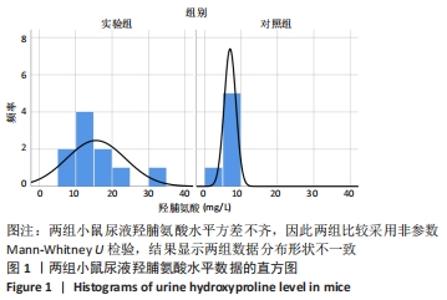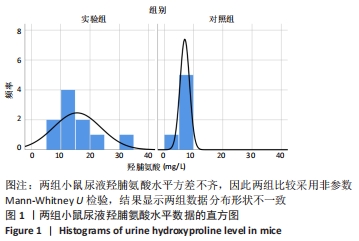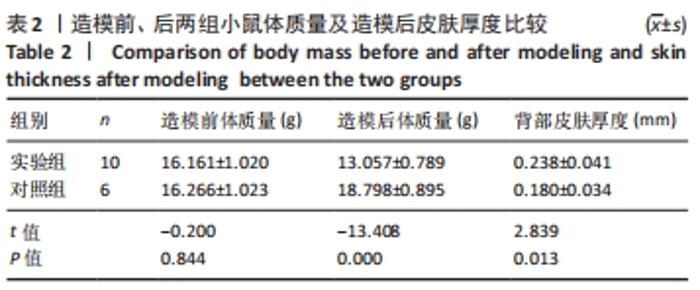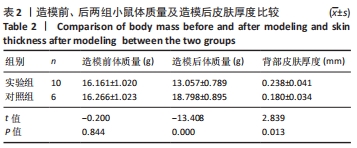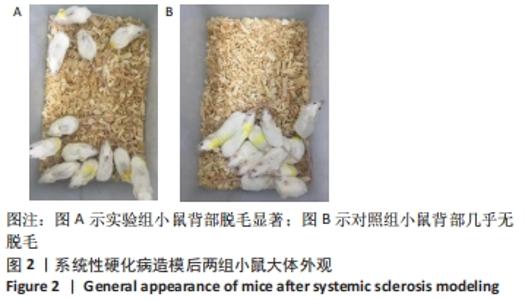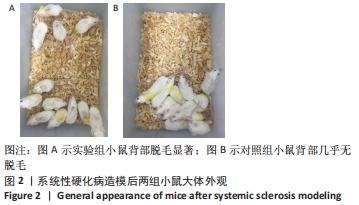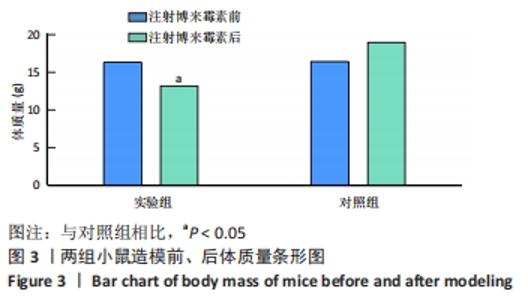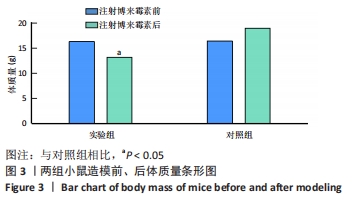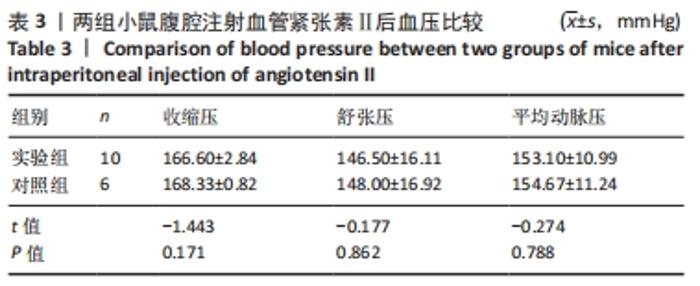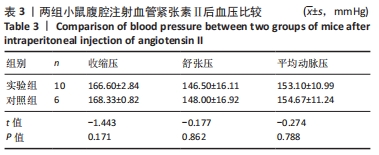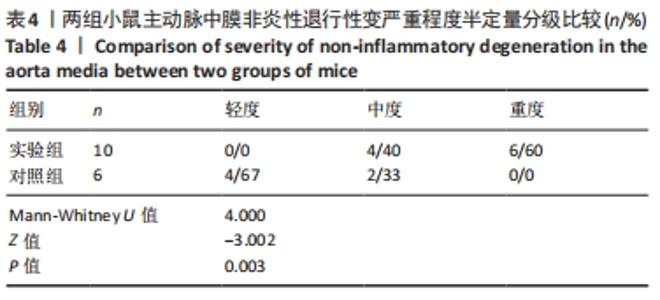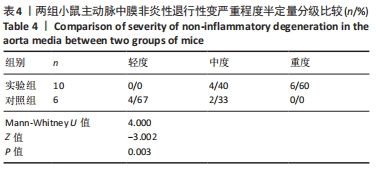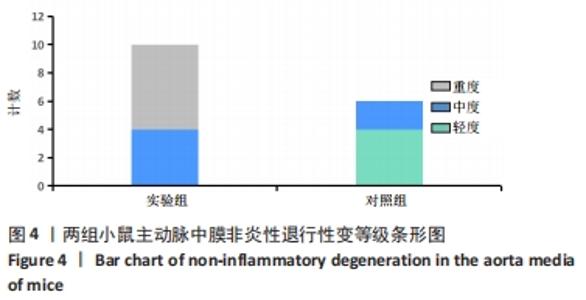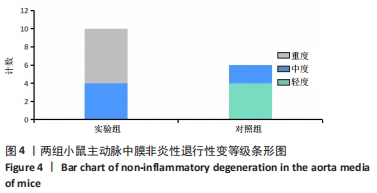Chinese Journal of Tissue Engineering Research ›› 2023, Vol. 27 ›› Issue (14): 2194-2199.doi: 10.12307/2023.164
Previous Articles Next Articles
Bleomycin combined with angiotensin II for establishing a mouse model of aortic dissection
Yang Lijuan1, Yao Na2, Lu Ruiwen2, Liu Xiaoyu2, Wang Baojun1
- 1Baotou Central Hospital, Baotou 014040, Inner Mongolia Autonomous Region, China; 2Baotou Medical College, Baotou 014060, Inner Mongolia Autonomous Region, China
-
Received:2022-03-01Accepted:2022-05-19Online:2023-05-18Published:2022-09-30 -
Contact:Wang Baojun, MD, Chief physician, Baotou Central Hospital, Baotou 014040, Inner Mongolia Autonomous Region, China -
About author:Yang Lijuan, MD, Chief physician, Baotou Central Hospital, Baotou 014040, Inner Mongolia Autonomous Region, China -
Supported by:the Natural Science Foundation of Inner Mongolia Autonomous Region, No. 2020MS08065 (to YLJ)
CLC Number:
Cite this article
Yang Lijuan, Yao Na, Lu Ruiwen, Liu Xiaoyu, Wang Baojun. Bleomycin combined with angiotensin II for establishing a mouse model of aortic dissection[J]. Chinese Journal of Tissue Engineering Research, 2023, 27(14): 2194-2199.
share this article
Add to citation manager EndNote|Reference Manager|ProCite|BibTeX|RefWorks
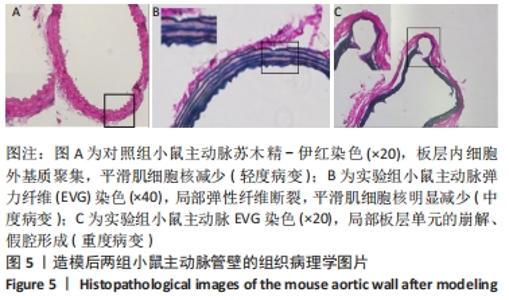
2.7 两组小鼠主动脉苏木精-伊红和EVG染色结果 两组小鼠主动脉苏木精-伊红染色结果都表现出不同程度的主动脉中膜非炎性退行性变,EVG染色特别突出了弹性纤维的病变。实验组小鼠主动脉中膜非炎性退行性变严重,6只为重度主动脉非炎性退行性变,表现为广泛的弹性纤维排列紊乱、断裂,大量的平滑肌细胞核缺失或不完整,广泛的板层间和或板层内黏液样细胞外基质聚集,板层单元结构崩解,其中1只合并假腔形成;4只为中度主动脉非炎性退行性变,表现为局部弹性纤维排列紊乱、断裂,多数平滑肌细胞核不完整,局部板层间和或板层内广泛的黏液样细胞外基质聚集。对照组6只表现为轻-中度主动脉中膜非炎性退行性变,其中2只为中度病变,4只为轻度退行性变,表现为平滑肌细胞核减少,板层内局部黏液样细胞外基质聚集。详见图5。"
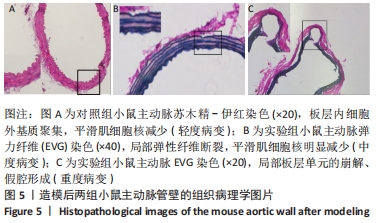
| [1] SMEDBERG C, STEUER J, LEANDER K, et al. Sex differences and temporal trends in aortic dissection: a population-based study of incidence, treatment strategies, and outcome in Swedish patients during 15 years. Eur Heart J. 2020;41(26):2430-2438. [2] 李莹, 范瑞新. 胸主动脉瘤/主动脉夹层的基因组学研究进展[J]. 岭南心血管病杂志,2021,27(3):382-386. [3] 白韬, 田文海, 唐康岁, 等. 主动脉夹层及动脉瘤的分子生物学机制研究现状[J]. 广州医科大学学报,2021,49(5):161-164. [4] 邓钧安. MicroRNA调控主动脉夹层发病的研究进展[J]. 中国心血管病研究,2016,14(5):397-401. [5] 赵艳丽, 陈东, 商建峰, 等. 主动脉非炎性病变的病因、发病机制及病理变化的研究进展[J]. 诊断病理学杂志,2021,28(4):295-299. [6] PTASZEK LM, KIM K, SPOONER AE, et al. Marfan syndrome is associated with recurrent dissection of the dissected aorta. Ann Thorac Surg. 2015;99(5):1616-1623. [7] ADHAM S, BILLON C, LEGRAND A, et al. Spontaneous Cervical Artery Dissection in Vascular Ehlers-Danlos Syndrome: A Cohort Study. Stroke. 2021;52(5):1628-1635. [8] GDYNIA HJ, KÜHNLEIN P, LUDOLPH AC, et al. Connective tissue disorders in dissections of the carotid or vertebral arteries. J Clin Neurosci. 2008;15(5):489-494. [9] NAKAMURA M, YAJIMA J, OIKAWA Y, et al. Vascular Ehlers-Danlos syndrome--all three coronary artery spontaneous dissections. J Cardiol. 2009;53(3):458-462. [10] BLECH B, DHAMIJA R, INGALL T. Marfan Syndrome Presenting as Spontaneous Coronary Artery Dissection and Arteriopathy. Neurologist. 2021;27(1):34-36. [11] LOPRESTI MA, GHALI MZ, SRINIVASAN VM, et al. Neurovascular findings in children and young adults with Loeys-Dietz syndromes: Informing recommendations for screening. J Neurol Sci. 2020;409:116633. [12] HENRARD C, BELGE H, FASTRÉ S, et al. Cervical artery dissection: fibromuscular dysplasia versus vascular Ehlers-Danlos syndrome. Blood Press. 2019;28(2):139-143. [13] DEBETTE S, GERMAIN DP. Neurologic manifestations of inherited disorders of connective tissue. Handb Clin Neurol. 2014;119:565-576. [14] GIOSSI A, RITELLI M, COSTA P, et al. Connective tissue anomalies in patients with spontaneous cervical artery dissection. Neurology. 2014; 83(22):2032-2037. [15] HALUSHKA MK, ANGELINI A, BARTOLONI G, et al. Consensus statement on surgical pathology of the aorta from the Society for Cardiovascular Pathology and the Association For European Cardiovascular Pathology: II. Noninflammatory degenerative diseases - nomenclature and diagnostic criteria. Cardiovasc Pathol. 2016;25(3):247-257. [16] 肖子亚, 姚晨玲, 顾国嵘. 主动脉夹层发病机制研究概述[J]. 中华心血管病杂志,2016,44(7):642-645. [17] 薛凌, 罗建方, 麦劲壮, 等. 广州市主动脉夹层临床特征变化趋势十年回顾性分析[J]. 中华心血管病杂志,2007,35(1):47-50. [18] 张源明, 陈曦, 木胡牙提, 等. 乌鲁木齐市主动脉夹层病例临床特征变化趋势10年回顾性分析[J]. 中华流行病学杂志,2008,29(7): 720-723. [19] 李卫民, 左景珍, 于昂, 等. 主动脉夹层的病理形态学研究[J]. 天津医药,2002,30(7):396-398. [20] 陆晓凤, 罗婧莹. 硬皮病动物模型建模药物最适浓度探讨[J]. 中国现代医学杂志,2016,26(1):1-4. [21] 黄婧, 李梦涛, 曾小峰. 药物诱导硬皮病[J]. 协和医学杂志,2014, 5(2):192-196. [22] 张立魁, 王文豪, 马希, 等. BAPN联合Ang-Ⅱ腹腔注射建立小鼠主动脉夹层模型. 中西医结合心脑血管病杂志,2020,18(4):579-582. [23] 苏敏红, 江宁, 李洪涛, 等. 腹腔注射博来霉素诱导小鼠肺纤维化模型的长期稳定性[J]. 中国组织工程研究,2017,21(4):512-519. [24] 杨俊, 邬光敏, 付品婷, 等. 胸主动脉夹层动物模型研究进展[J]. 中国普通外科杂志,2020,29(12):1503-1508. [25] 陈书媛, 张彦宁. EVG 弹力纤维染色方法的改良和效果观察[J]. 临床和实验医学杂志,2016,15(7):716-718. [26] TRACHET B, PIERSIGILLI A, FRAGA-SILVA RA, et al. Ascending Aortic Aneurysm in Angiotensin II-Infused Mice: Formation, Progression, and the Role of Focal Dissections. Arterioscler Thromb Vasc Biol. 2016; 36(4):673-681. [27] ASLANIDOU L, TRACHET B, SASSET L, et al. Early Morphofunctional Changes in AngII-Infused Mice Contribute to Regional Onset of Aortic Aneurysm and Dissection. J Vasc Res. 2020;57(6):367-375. [28] PHILLIPS EH, CHANG MS, GORMAN S, et al. Angiotensin II Infusion Does Not Cause Abdominal Aortic Aneurysms in Apolipoprotein E-Deficient Rats. J Vasc Res. 2018;55(1):1-12. [29] TRACHET B, ASLANIDOU L, PIERSIGILLI A, et al. Angiotensin II infusion into ApoE-/- mice: a model for aortic dissection rather than abdominal aortic aneurysm? Cardiovasc Res. 2017;113(10):1230-1242. [30] GAO YX, LIU YT, ZHANG YY, et al. [Establishment of β-aminopropionitrile-induced aortic dissection model in C57Bl/6J mice]. Zhonghua Xin Xue Guan Bing Za Zhi. 2018;46(2):137-142. [31] LEMAIRE SA, ZHANG L, LUO W, et al. Effect of Ciprofloxacin on Susceptibility to Aortic Dissection and Rupture in Mice. JAMA Surg. 2018;153(9):e181804. [32] ULNDREAJ A, LI A, CHEN Y, et al. Adventitial recruitment of Lyve-1- macrophages drives aortic aneurysm in an angiotensin-2-based murine model. Clin Sci (Lond). 2021;135(10):1295-1309. [33] TOMITA H, HAGAMAN J, FRIEDMAN MH, et al. Relationship between hemodynamics and atherosclerosis in aortic arches of apolipoprotein E-null mice on 129S6/SvEvTac and C57BL/6J genetic backgrounds. Atherosclerosis. 2012;220(1):78-85. [34] WANG F, TU Y, GAO Y, et al. Smooth Muscle Sirtuin 1 Blocks Thoracic Aortic Aneurysm/Dissection Development in Mice. Cardiovasc Drugs Ther. 2020;34(5):641-650. [35] LI H, GUO J, JIA Y, et al. LOXL4 Abrogation Does Not Exaggerate Angiotensin II-Induced Thoracic or Abdominal Aortic Aneurysm in Mice. Genes (Basel). 2021;12(4):513. [36] 李江涛, 李天红, 谭静雅, 等. 博来霉素诱导硬皮病小鼠基础研究[J]. 四川医学,2014,35(7):761-764. [37] 冯俊波, 葛圣林, 刘海渊. 血管紧张素-Ⅱ腹腔注射建立小鼠主动脉夹层动物模型[J]. 中华实验外科杂志,2013,30(2):399-400. |
| [1] | Cheng Mingguang, Zhang Chaoyu, Zhuang Kangle, Ruan Peng, Zuo Yi, Zhou Zhengchun, Kong Xiang, Ge Jianjun, Cheng Guangcun. In vitro construction of Stanford type A aortic dissection 3D dynamic simulation diagram and individual tissue-engineered blood vessels [J]. Chinese Journal of Tissue Engineering Research, 2023, 27(3): 335-338. |
| [2] | Liu Ya, Liu Xia, Deng Penghui, Ji Wei, Li Jianping. Exercise effects on myocardial type I, III collagen and angiotensin II/transforming growth factor beta1/Smad2 pathway in diabetic myocardial fibrosis rats [J]. Chinese Journal of Tissue Engineering Research, 2022, 26(26): 4173-4179. |
| [3] | Guo Qiqi, Li Yi, Weng Huanze, Wang Qian, Jia Min. Advances in animal models of pulmonary fibrosis induced by biotic and abiotic factors [J]. Chinese Journal of Tissue Engineering Research, 2022, 26(14): 2273-2278. |
| [4] | Wen Miaomiao, Fan Junbai. Relationship between biological activities of Apelin and Elabela and diseases [J]. Chinese Journal of Tissue Engineering Research, 2021, 25(35): 5735-5740. |
| [5] | Zhang Jingying, Sun Xiaolin, Geng Lixia. Therapeutic mechanism of adipose mesenchymal stem cells in mice with systemic sclerosis [J]. Chinese Journal of Tissue Engineering Research, 2021, 25(13): 2011-2017. |
| [6] | Cheng Xue, Fang Hong, Zhang Yunke, Wu Yingen. Interventional mechanism of Feibi prescription on extracellular matrix transformation in a mouse model of pulmonary fibrosis [J]. Chinese Journal of Tissue Engineering Research, 2020, 24(31): 5038-5043. |
| [7] | Liu Baoyi1, Li Minde1, Yang Fan2, Li Shaopeng1, Chen Haojie1, Xiao Peng1. Angiotensin II promotes steroid-induced avascular necrosis of the femoral head in mice [J]. Chinese Journal of Tissue Engineering Research, 2019, 23(19): 3044-3049. |
| [8] | Li Qin, Li Yan, Gao Shanshan, Zheng Jintao. Pathways of astragalus polysaccharide inhibiting angiotensin II-induced cardiac hypertrophy [J]. Chinese Journal of Tissue Engineering Research, 2019, 23(19): 3086-3091. |
| [9] | Wang Wei, Huang Yu-cheng, Chen Yan-hui. Effects of adipose-derived mesenchymal stem cells on fibroblast proliferation in mouse scleroderma lesions and underlying mechanisms [J]. Chinese Journal of Tissue Engineering Research, 2018, 22(33): 5249-5254. |
| [10] | Su Min-hong1, Jiang Ning2, Li Hong-tao3, Wang Zhen-guo1, Xie Yu-fen1, Zheng Xiao-bin1, Tu Chang-li1,Huang Jin1. Intraperitoneal injection of bleomycin induces pulmonary fibrosis in mice: a long-term stability evaluation [J]. Chinese Journal of Tissue Engineering Research, 2017, 21(4): 512-519. |
| [11] | Wang Jing, Han Jiang-hong, Li Qiong. 5-Azacytidine combined with angiotensin II induces differentiation of adipose-derived mesenchymal stem cells into cardiomyocytes [J]. Chinese Journal of Tissue Engineering Research, 2017, 21(29): 4629-4634. |
| [12] | Yan Ping, Hou Jing-ying, Zheng Shao-xin, Long Hui-bao, Zhong Ting-ting, Zhou Chang-qing, Guo Tian-zhu, Wu Quan-hua, Wang Tong. Cardiac stem cells improve the electrophysiological stability and ventricular fibrillation threshold via ANGII/AT1R/TGF-beta1/SMAD/CX43 signaling pathway [J]. Chinese Journal of Tissue Engineering Research, 2016, 20(28): 4226-4233. |
| [13] | Song Yang, Wu Rong, Zeng Yue-can, Zhang Zhen-yong, Du Hong-mei. Protective effect of pioglitazone in rat models of radiation-induced heart injury [J]. Chinese Journal of Tissue Engineering Research, 2015, 19(5): 674-680. |
| [14] | Tu Chang-li, Liu Xiang, Zheng Xiao-bin, Yu Jia-lin, Zhu Shu-qin, Su Min-hong, Wu Wei-ming, Huang Jin. Intravenous injection of bleomycin induces pulmonary fibrosis in mice: a stability evaluation [J]. Chinese Journal of Tissue Engineering Research, 2015, 19(40): 6436-6443. |
| [15] | She Shu-song, Zhou Bo, Xu Shun-cai. Effects of different ventilation modes on stress reaction of hypertensive patients treated with hip arthroplasty [J]. Chinese Journal of Tissue Engineering Research, 2015, 19(35): 5588-5592. |
| Viewed | ||||||
|
Full text |
|
|||||
|
Abstract |
|
|||||
